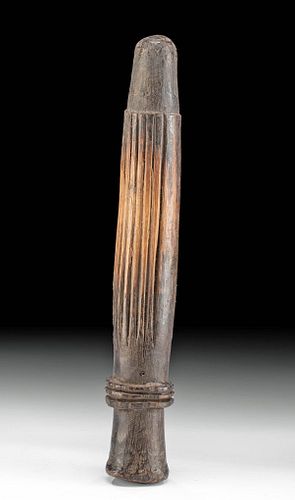Mid-20th C. Papua New Guinea Wood Tapa Beater
Lot 122
About Seller
Artemis Gallery
686 S Taylor Ave, Ste 106
Louisville, CO 80027
United States
Selling antiquities, ancient and ethnographic art online since 1993, Artemis Gallery specializes in Classical Antiquities (Egyptian, Greek, Roman, Near Eastern), Asian, Pre-Columbian, African / Tribal / Oceanographic art. Our extensive inventory includes pottery, stone, metal, wood, glass and textil...Read more
Categories
Estimate:
$500 - $750
Absentee vs Live bid
Two ways to bid:
- Leave a max absentee bid and the platform will bid on your behalf up to your maximum bid during the live auction.
- Bid live during the auction and your bids will be submitted real-time to the auctioneer.
Bid Increments
| Price | Bid Increment |
|---|---|
| $0 | $25 |
| $300 | $50 |
| $1,000 | $100 |
| $2,000 | $250 |
| $5,000 | $500 |
| $10,000 | $1,000 |
| $20,000 | $2,500 |
| $50,000 | $5,000 |
| $100,000 | $10,000 |
| $200,000 | $20,000 |
About Auction
By Artemis Gallery
Jun 24, 2021
Set Reminder
2021-06-24 10:00:00
2021-06-24 10:00:00
America/New_York
Bidsquare
Bidsquare : VARIETY SALE | Ancient & Ethnographic Art
https://www.bidsquare.com/auctions/artemis-gallery/variety-sale-ancient-ethnographic-art-7119
Featuring classical antiquities, ancient and ethnographic art. Egyptian, Greek, Roman, Etruscan, Near Eastern, Asian, Pre-Columbian, Native American, African / Tribal, Oceanic, Spanish Colonial, Russian, Fossils, Fine Art, more! All legally acquired, legal to sell. Satisfaction guaranteed. Artemis Gallery info@artemisgallery.com
Featuring classical antiquities, ancient and ethnographic art. Egyptian, Greek, Roman, Etruscan, Near Eastern, Asian, Pre-Columbian, Native American, African / Tribal, Oceanic, Spanish Colonial, Russian, Fossils, Fine Art, more! All legally acquired, legal to sell. Satisfaction guaranteed. Artemis Gallery info@artemisgallery.com
- Lot Description
Oceania, Papua New Guinea, ca. mid to late 20th century CE. A fine tapa cloth beater, hand-carved from an espresso-hued hard wood. The beater has a short, flared handle and a cylindrical beating head with a narrow top section. A set of three risen bands separate handle from the head. The head of the beater has 9 vertical incised striations meant to evenly flatten the fibers of the tapa bark intended for manufacturing into textiles. Tapa cloths are traditionally made by beating the inner bark of mulberry or similar trees until it is soft and pliable, and then painted using a palette of naturally occurring pigments. This example is a solid, elegant tool used to create true works of art. Size: 2.875" in diameter x 13" H (7.3 cm x 33 cm)
Tapa is a particular kind of bark cloth that is made in the South Pacific Islands - mainly Tonga, Samoa, and Fiji - but also as far afield as Hawaii and Papua New Guinea. Tapa was introduced to the Western world in the late 18th century by Captain Cook's first expedition, where it was collected under the direction of Joseph Banks and brought to Europe. In the South Pacific, Hawaii, and Papua New Guinea, the cloth is still of great social importance and is often given as a gift. Interestingly, it was also once used for everyday clothing before synthetic fabrics replaced it. Today, however, it is worn only at special occasions such as weddings.
Provenance: private Newport Beach, California, USA collection
All items legal to buy/sell under U.S. Statute covering cultural patrimony Code 2600, CHAPTER 14, and are guaranteed to be as described or your money back.
A Certificate of Authenticity will accompany all winning bids.
We ship worldwide and handle all shipping in-house for your convenience.
#142260Surface wear on one side, as well as nicks, scratches, and abrasions, commensurate with use. Otherwise, intact and excellent with lovely patina.Condition
- Shipping Info
-
All shipping is handled in-house for your convenience. Your invoice from Artemis Gallery will include shipping calculation instructions. If in doubt, please inquire BEFORE bidding for estimated shipping costs for individual items.
-
- Buyer's Premium



 EUR
EUR CAD
CAD AUD
AUD GBP
GBP MXN
MXN HKD
HKD CNY
CNY MYR
MYR SEK
SEK SGD
SGD CHF
CHF THB
THB














